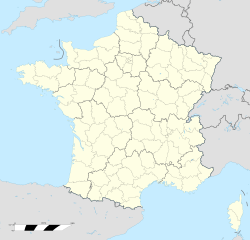Téviec facts for kids
| Geography | |
|---|---|
| Location | Europe |
| Coordinates | 47°33′21″N 3°9′54″W / 47.55583°N 3.16500°W |
| Archipelago | Quiberon |
| Administration | |
|
France
|
|
| Region | Brittany |
| Department | Morbihan |
Téviec (also spelled Théviec) is a small island located off the coast of Brittany, France. It sits west of the Quiberon peninsula, near the town of Saint-Pierre-Quiberon. This island is very important for archaeologists because people lived there a very long time ago, during the Mesolithic period.
Archaeologists have found many amazing things on Téviec. These discoveries date back over 6,700 years! They include the remains of more than 20 people. One of the most famous finds was the grave of two young women. They seemed to have died from injuries, but they received a very special burial. Their grave was covered with a "roof" made of antlers, and their bodies were decorated with beautiful jewelry made from shells.
Contents
Protecting Téviec Island
Téviec is a privately owned island. Since 1982, it has been part of a special plan to protect its natural environment, called a biotope protection scheme. A biotope is an area with a specific type of habitat and the living things that call it home. This plan helps keep the island's unique plants and animals safe.
Because of this protection, landing on Téviec Island is usually not allowed. This rule is in place from April 15th to August 31st each year. This helps protect the wildlife, especially during nesting seasons.
Discovering Ancient Life: Téviec's Archaeological Sites
Between 1928 and 1934, archaeologists Marthe and Saint-Just Péquart explored Téviec. They found and dug up ancient living areas and a burial ground from the Mesolithic period. The Mesolithic period is also known as the Middle Stone Age. During this time, people were hunter-gatherers, meaning they hunted animals and gathered plants for food.
Téviec is one of only a few known Mesolithic sites in Brittany. Other important sites include Pointe de la Torche and Hoëdic. Thousands of years ago, during the Mesolithic period, the sea level was much lower than it is today. It was even possible to walk from France to England! At that time, Téviec was part of a lagoon, which is a shallow body of water separated from the sea by a narrow strip of land.
Archaeologists found large piles of ancient trash, called middens, near where people lived on the island. These middens contained the remains of many things the ancient people ate. They found shells from shellfish, bones from fish, birds, and even large sea animals like whales. There were also bones from land animals such as wild boar, red deer, and roe deer. Even bones of dogs were found.
The hunter-gatherers of Téviec buried their dead right inside these middens. This was actually very helpful for preserving the graves. The shells in the middens contain carbonates, which protected the human bones from the acidic soil. This allowed the remains to survive for thousands of years.
Tools and Time Periods
Many tools made from bone and antler were found on Téviec. Archaeologists also discovered many small, sharp flint tools called microliths. These tiny tools were often used as parts of larger tools, like arrowheads or spear tips.
At first, scientists thought these tools were about 6,575 years old. But newer dating methods show they are actually between 6,740 and 5,680 years old. This means people lived on Téviec for a longer time than first thought. Their time on the island ended around the beginning of the Neolithic period, which is when farming started to become common.
The Burials of Téviec
Archaeologists found ten different graves on Téviec. These graves held a total of 23 people, including both adults and children. Some of the human remains were found scattered in different places.
Several of the people buried on Téviec showed signs of injury. For example, one person was found with a flint arrowhead stuck in their spine. In another grave, the skeletons of two women, aged 25–35, were found. These women are often called the "ladies of Téviec." Both skeletons showed signs of injuries. One woman had several marks on her head, and it looked like she had been hit by an arrow between her eyes. The other woman also had traces of injuries. However, some archaeologists disagree about these findings. They suggest that the weight of the earth on top of the grave might have caused some of the damage to the skeletons over time.
The bodies had been buried with great care. They were placed in a pit dug partly into the ground. This pit was then covered with debris from the midden. A special "roof" made of antlers protected the bodies. The people were also buried with "grave goods," which are items placed with the dead. These included pieces of flint, boar bones, and beautiful jewelry made from sea shells. The shells were drilled and put together to make necklaces, bracelets, and rings for their legs.
The entire grave, with all its contents, was carefully removed from the site in one piece. Today, you can see it on display at the Muséum de Toulouse in France. In 2010, the museum won a national award for how well they restored and presented this amazing discovery.


